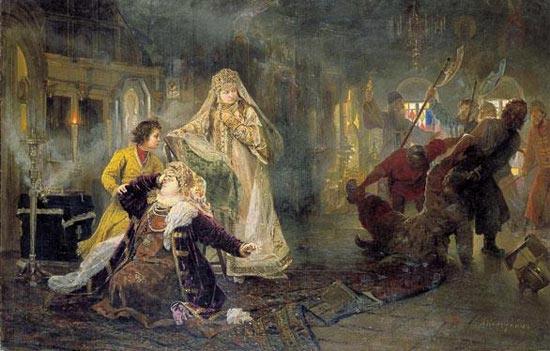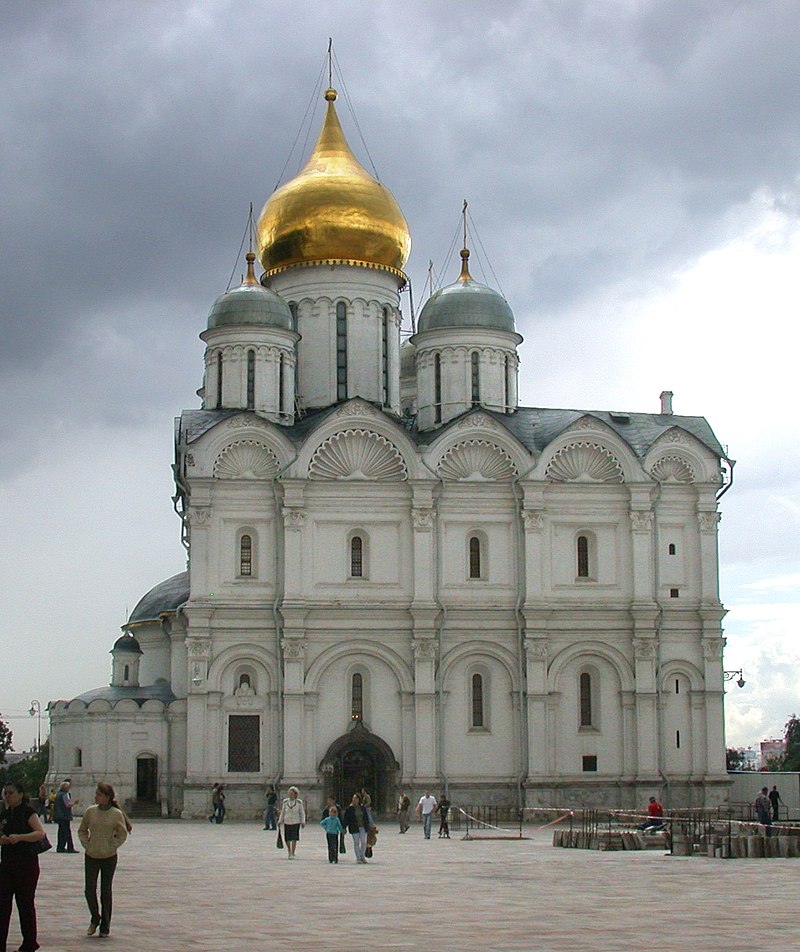by Susan Flantzer © Unofficial Royalty 2018

Credit – Wikipedia
Natalya Kirillovna Naryshkina was the second wife of Alexei I, Tsar of All Russia and the mother of Peter I (the Great), Emperor of All Russia. The eldest of the seven children of Kirill Poluektovich Naryshkin and his wife Anna Leontyevna Leontyeva, Natalya Kirillovna was born in Moscow on September 1, 1651. She was brought up in the Moscow home of her distant relative, the Western-influenced statesman, diplomat, and reformer Artamon Sergeyevich Matveev. Mateev even married a Western woman, Eudoxie Hamilton from Scotland. Because of Mateev’s influence, Natalya Kirillovna’s upbringing was freer and more Western than that of other Russian women of that time period. Natalya’s upbringing certainly had an influence on her son Peter the Great who was greatly influenced by Western advisers and implemented major reforms to modernize Russia.
Natalya Kirillovna had six younger siblings:
- Ivan Kirillovich (1658 – 1682), married Praskovia Alexeevna Lykova, no children, killed during the Streltsy Uprising of 1682
- Afanasii Kirillovich (1662 – 1682), killed during the Streltsy Uprising of 1682
- Lev Kirillovich (1664 – 1705), married (1) Praskovia Feodorovna, had seven children (2) Anna Petrovna Saltykova, had two children
- Martemian Kirillovich (1665 – 1697), married Tsarevna Evdokiya Vasilievna of Siberia, had one daughter
- Feodor Kirillovich (1666 – 1691), married Praskovia Dmitrievna Golitsyna
- Evdokia Kirillovna (died 1682)
In 1669, Maria Ilyinichna Miloslavskaya, the first wife of Alexei I, Tsar of All Russia, died due to childbirth complications following the birth of her thirteenth child who also died. Nineteen-year-old Natalya Kirillovna Naryshkina was picked as Alexei’s second wife during a bride-show, a custom of Byzantine emperors and Russian tsars used to choose a wife from among the most beautiful young women in the country. On February 1, 1671, the couple was married in Moscow. Alexei’s only surviving sons from his first marriage were the future Tsars Feodor III, who was disabled by an unknown disease that left him disfigured and partially paralyzed, and Ivan V, who had serious physical and mental disabilities. Alexei hoped his second marriage would give him a healthy son, and it did, Peter the Great.

Marriage of Natalya and Alexei; Credit – Wikipedia
Natalya Kirillovna and Alexei had three children:
- Peter I (the Great), Emperor of All Russia (1672–1725), married (1) Eudoxia Feodorovna Lopukhina, had three sons including Alexei Petrovich, Tsarevich of Russia (2) Martha Skavronskaya (Catherine I, Empress of All Russia who succeeded Peter), had eleven children, only two daughters survived childhood Grand Duchess Anna Petrovna (mother of Peter III, Emperor of All Russia) and Elizabeth, Empress of All Russia
- Tsarevna Natalya Alexeievna (1673–1716), unmarried, a playwright and founder of the first public theater in Russia
- Tsarevna Fyodora Alexeievna (1674–1677)
On February 9, 1676, five years after marrying Natalya, Alexei I, Tsar of All Russia died of a heart attack at the age of 46. He was succeeded by his eldest surviving son from his first marriage, 15-year-old Feodor III. Even though Feodor was well educated and had a fine intellect, his debilitating physical condition prevented him from really reigning. Throughout Feodor’s reign, the government was largely run by Artamon Sergeyevich Matveev, who had raised Natalya Kirillovna and had become a close friend of her husband Alexei. Feodor married twice but he had no surviving children and died on May 7, 1682, at the age of 20.
Feodor’s death triggered the Streltsy Uprising of 1682, a struggle for the succession between the families of the two wives of Alexei I. Alexei’s son by his first wife, Feodor III, left no surviving heir. Feodor was followed next in the line of succession by his only surviving full brother, the 15-year-old Ivan, who had serious physical and mental disabilities. The family of Natalya Kirillovna Naryshkina, instead wanted Natalya’s ten-year-old son Peter to succeed. The Boyar Duma, a council of Russian nobles, chose Peter to become Tsar of All Russia with his mother as regent.
Sophia Alexeevna, Alexei’s eldest surviving daughter from his first marriage and Ivan’s sister, led a rebellion of the Streltsy, an elite military corps, in April – May 1682. During the rebellion, some of Peter’s relatives and allies were murdered, including two of his maternal uncles and his father’s good friend Artamon Sergeyevich Matveev. The young Peter witnessed some of these violent acts.

Ivan Naryshkin, Natalya’s brother, is dragged out of the palace while Peter I consoles his mother and Sophia watches with satisfaction; Credit – Wikipedia
The rebellion made it possible for Sophia Alexeevna, her maternal family the Miloslavskys, and their allies to insist that Peter and Ivan be proclaimed joint Tsars, with Ivan being the senior Tsar. Sophia acted as regent during the minority of Ivan and Peter and ruled as an autocrat. During this period, Natalya Kirillovna received her only financial support from the Patriarch of the Russian Orthodox Church and lived away from the court at Alexei’s former summer residence in Preobrazhenskoye near Moscow.
In 1689, 17-year-old Peter overthrew his half-sister Sophia Alexeevna. Peter I and Ivan V continued as co-tsars, and Sophia was forced to enter a convent and give up her position as a member of the royal family. Because of his young age, Peter could not acquire actual control over Russian affairs. Instead, the power was controlled by his mother and her brother Lev Naryshkin who was appointed the minister of foreign affairs and was the de facto prime minister.
It was not until his mother died in 1694 and his half-brother’s death in 1696 that Peter assumed complete authority. Natalya Kirillovna died from heart disease at the age of 42 on February 4, 1694, at the Moscow Kremlin. She was buried at the Ascension Convent, a Russian Orthodox nunnery in the Moscow Kremlin where royal and noble women were buried. In 1929, the Ascension Convent was dismantled by the Soviets to make room for the Red Commanders School. At that time, the remains of those buried there were moved to the crypt of the Archangel Cathedral in the Moscow Kremlin.

Ascension Convent, Natalya Kirillovna’s original burial place; Photo Credit – Wikipedia

Archangel Cathedral, Natalya Kirillovna’s current burial place; Photo Credit – Wikipedia
This article is the intellectual property of Unofficial Royalty and is NOT TO BE COPIED, EDITED, OR POSTED IN ANY FORM ON ANOTHER WEBSITE under any circumstances. It is permissible to use a link that directs to Unofficial Royalty.
Romanov Resources at Unofficial Royalty
- Tsardom of Russia/Russian Empire Index
- Romanov Births, Marriages and Deaths
- Romanov Burial Sites
- Romanovs Killed During the Russian Revolution
- Romanovs Who Survived the Russian Revolution
Works Cited
- En.wikipedia.org. (2017). Natalya Naryshkina. [online] Available at: https://en.wikipedia.org/wiki/Natalya_Naryshkina [Accessed 7 Dec. 2017].
- Lincoln, W. Bruce. (1981). The Romanovs: Autocrats of All the Russias. New York, NY.: Doubleday
- Ru.wikipedia.org. (2017). Нарышкина, Наталья Кирилловна. [online] Available at: https://ru.wikipedia.org/wiki/%D0%9D%D0%B0%D1%80%D1%8B%D1%88%D0%BA%D0%B8%D0%BD%D0%B0,_%D0%9D%D0%B0%D1%82%D0%B0%D0%BB%D1%8C%D1%8F_%D0%9A%D0%B8%D1%80%D0%B8%D0%BB%D0%BB%D0%BE%D0%B2%D0%BD%D0%B0 [Accessed 7 Dec. 2017].
